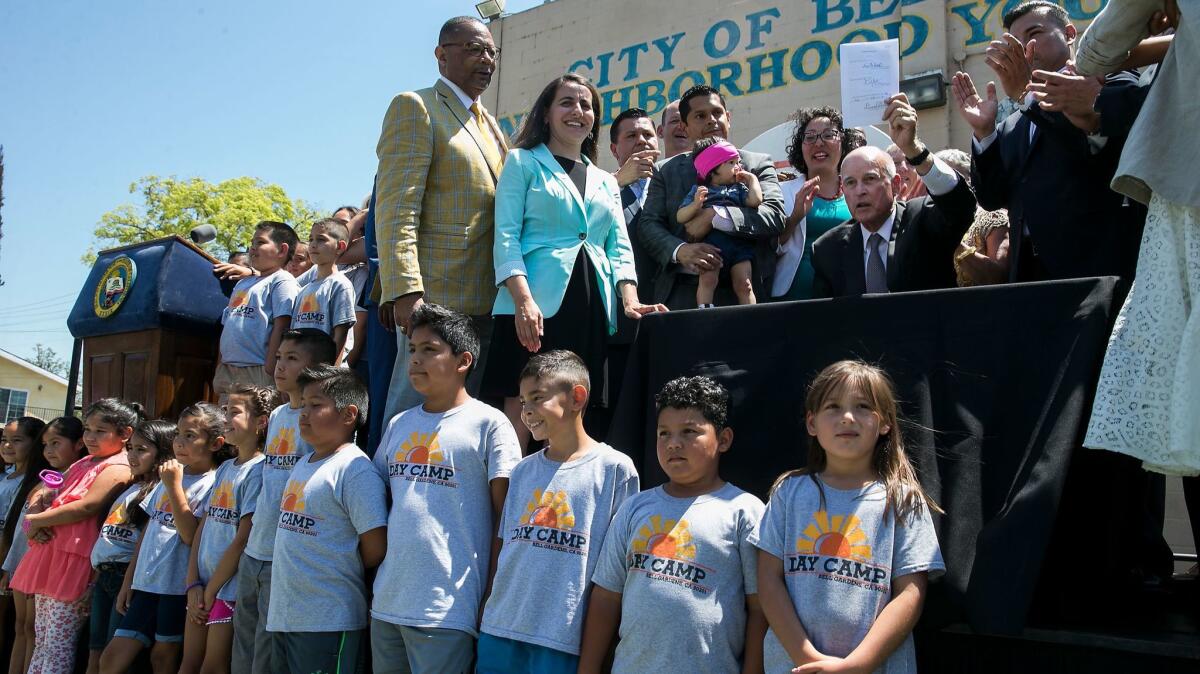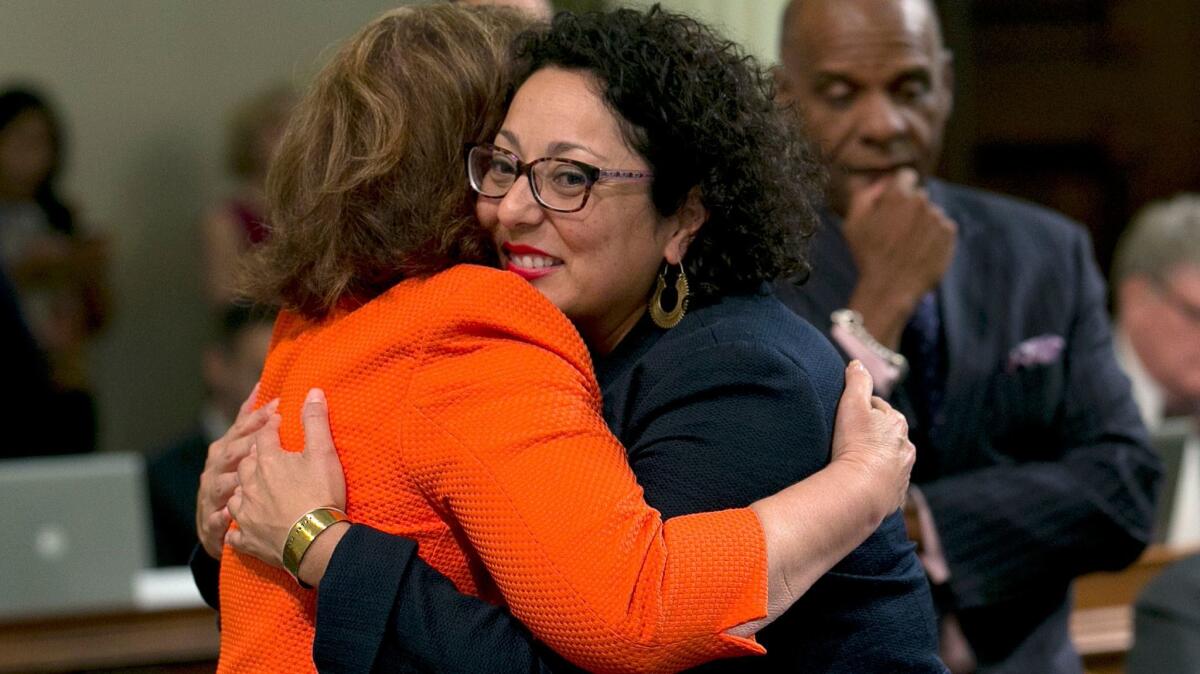Questions remain as Gov. Brown signs legislation to address neighborhood-level air pollution

Gov. Jerry Brown on Wednesday signed legislation aimed at improving air quality in disadvantaged communities, a key step in shifting the debate over how the state fights climate change and an issue that has tested the influence of environmental justice advocates
The law imposes new requirements to monitor and reduce pollution in neighborhoods where houses and schools are squeezed between oil refineries, industrial facilities and freight corridors. Ramping up efforts to alleviate asthma and other health problems was part of a broader deal to extend the cap-and-trade program for cutting greenhouse gases, a priority for the governor.
The focus now shifts to state and local regulators, who are responsible for implementing the law despite concerns that it isn’t stringent enough or well-funded.
Brown thanked activists “for lighting a fire under all these politicians” to tackle pollution, which he described as a dangerous byproduct of economic prosperity.
“That’s the dark paradox of modernity,” he said. “We get the goodies, but we get the poison with it. So today we’re taking a step to take the poison out as well as increase the prosperity and the goodies for all.”
Brown signed the legislation at a community center in Bell Gardens where, two months before, he had talked with activists about their concerns. Some of those activists remain unsatisfied, gathering outside the fence on Wednesday to chant over celebratory speeches. One held a sign saying “gobernador vendido” — “sellout governor.”
Angelo Logan, a member of East Yard Communities for Environmental Justice, said the governor had ignored their recommendations.
“It’s a slap in the face,” he said.

Environmental justice advocates, who focus more on local health issues than global concerns about rising temperatures, have been trying to increase their influence in Sacramento. They’ve been successful in a years-long effort to link the debate over air quality with the battle against global warming.
“It’s good that we think about our global community … but we need to make sure that communities like this are not left behind,” said Assemblywoman Cristina Garcia (D-Bell Gardens). She was an author of the legislation, AB 617, signed by Brown on Wednesday.
Mainstream environmental groups such as the Natural Resources Defense Council supported the measure, but it did not win over other activists. Some dislike its connection to the cap-and-trade program, which environmental justice advocates have long viewed as an inadequate tool for cracking down on major polluters such as the oil industry.

A breakdown of the cap and trade program.
Others described the air-quality legislation itself as too weak, particularly when it comes to emissions from cars and trucks that account for most of the state’s air pollution.
Activists also want to see more guarantees that regulators will force improvements. The new legislation “lacks the teeth and specificity needed to ensure that it will lead to improved health and air quality in our communities,” Strela Cervas and Amy Vanderwarker, the co-directors of the California Environmental Justice Alliance, wrote in an essay laying out their concerns.
Despite the hard feelings, lawmakers said environmental justice advocates have still gained ground, noting that improving air quality was viewed as a political prerequisite for extending cap and trade.
“They defined the terms of the debate even if they don’t feel like they won the debate,” Sen. Henry Stern (D-Canoga Park) said.
The mere presence of a law on air quality is a shift from 2006, when Gov. Arnold Schwarzenegger signed the state’s landmark global warming law, AB 32. There was no companion legislation specifically intended to help polluted communities.
There have also been changes at the Air Resources Board, the state’s top regulatory authority for climate issues. The board has grown to include two members representing environmental justice issues, plus two lawmakers sympathetic to their concerns.
Dean Florez, a former state senator who is one of the board’s more recent additions, said the new legislation should be seen as a “huge win” by providing “a huge toolbox” for improving air quality.
He said regulators now need to build trust with environmental justice advocates by following through.
“If we don’t do our job, they have every right to say, ‘See, we told you,’” Florez said.

The law requires the Air Resources Board to select locations in some of the state’s poorest and most polluted neighborhoods to deploy advanced air quality monitoring sensors, then select locations around the state for community emissions reductions programs, which local air districts would be tasked with carrying out.
Maximum penalties for air pollution violations are also being increased.
Another provision sets a 2023 deadline for upgrading pollution control equipment at refineries and other large facilities, although activists fear there’s enough wiggle room in the law for companies to avoid making the necessary investments.
The biggest test for the law will be in the Greater Los Angeles area, a region of more than 17 million people with the nation’s worst air pollution.
In recent years, residents and regulators have contended with a series of episodes in which air quality monitoring near industrial operations has revealed alarming hot spots of lead, chromium-6 and other dangerous pollutants in residential communities including Boyle Heights, Maywood, and Paramount.
But local regulators are concerned the new law does not provide the new funding necessary to make progress.
Although they want to reduce pollution “as quickly as feasible,” said Sam Atwood, a spokesman for the South Coast Air Quality Management District, “we remain concerned about the unfunded mandates in AB 617 — amounting to hundreds of millions of dollars statewide — for air monitoring and other requirements.”
[email protected] and [email protected]
@tonybarboza and @chrismegerian
ALSO
Here’s why progressives aren’t thrilled with Gov. Brown’s cap-and-trade plan
UPDATES:
6 p.m.: This article was updated with additional editing.
This article was originally published at 5:10 p.m.
More to Read
Sign up for Essential California
The most important California stories and recommendations in your inbox every morning.
You may occasionally receive promotional content from the Los Angeles Times.












